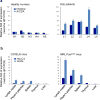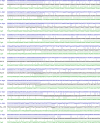AID dysregulation in lupus-prone MRL/Fas(lpr/lpr) mice increases class switch DNA recombination and promotes interchromosomal c-Myc/IgH loci translocations: modulation by HoxC4
- PMID: 21585311
- PMCID: PMC3762595
- DOI: 10.3109/08916934.2011.577128
AID dysregulation in lupus-prone MRL/Fas(lpr/lpr) mice increases class switch DNA recombination and promotes interchromosomal c-Myc/IgH loci translocations: modulation by HoxC4
Erratum in
- Autoimmunity. 2011 Dec;44(8):664
Abstract
Immunoglobulin gene somatic hypermutation (SHM) and class switch DNA recombination (CSR) play important roles in the generation of autoantibodies in systemic lupus erythematosus. Systemic lupus is characterized by the production of an array of pathogenic high-affinity mutated and class-switched, mainly IgG, antibodies to a variety of self-antigens, including nuclear components, such as dsDNA, histones, and chromatin. We previously found that MRL/Fas(lpr/lpr) mice, which develop a systemic autoimmune syndrome sharing many features with human lupus, display greatly upregulated CSR, particularly to IgG2a, in B cells of the spleen, lymph nodes, and Peyer's patches. In MRL/Fas(lpr/lpr) mice, the significant upregulation of CSR is associated with increased expression of activation-induced cytidine deaminase (AID), which is critical for CSR and SHM. We also found that HoxC4 directly activates the promoter of the AID gene to induce AID expression, CSR and SHM. Here, we show that in both lupus patients and lupus-prone MRL/Fas(lpr/lpr) mice, the expression of HoxC4 and AID is significantly upregulated. To further analyze the role of HoxC4 in lupus, we generated HoxC4(-/-) MRL/Fas(lpr/lpr) mice. In these mice, HoxC4-deficiency resulted in reduced AID expression, impaired CSR, and decreased serum anti-dsDNA IgG, particularly IgG2a, autoantibodies, which were associated with a reduction in IgG deposition in kidney glomeruli. In addition, consistent with our previous findings in MRL/Fas(lpr/lpr) mice that upregulated AID expression is associated with extensive DNA lesions, comprising deletions and insertions in the IgH locus, we found that c-Myc to IgH (c-Myc/IgH) translocations occur frequently in B cells of MRL/Fas(lpr/lpr) mice. The frequency of such translocations was significantly reduced in HoxC4(-/-) MRL/Fas(lpr/lpr) mice. These findings suggest that in lupus B cells, upregulation of HoxC4 plays a major role in dysregulation of AID expression, thereby increasing CSR and autoantibody production and promoting c-Myc/IgH translocations.
Conflict of interest statement
The authors report no conflicts of interest.
Figures







References
Publication types
MeSH terms
Substances
Grants and funding
LinkOut - more resources
Full Text Sources
Other Literature Sources
Medical
Research Materials
Miscellaneous
